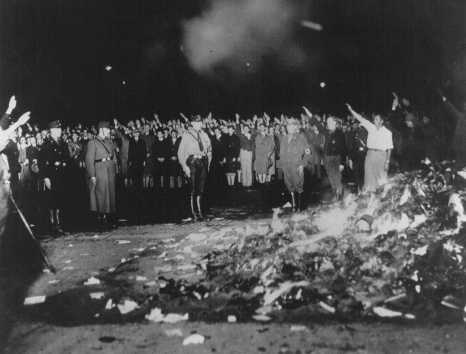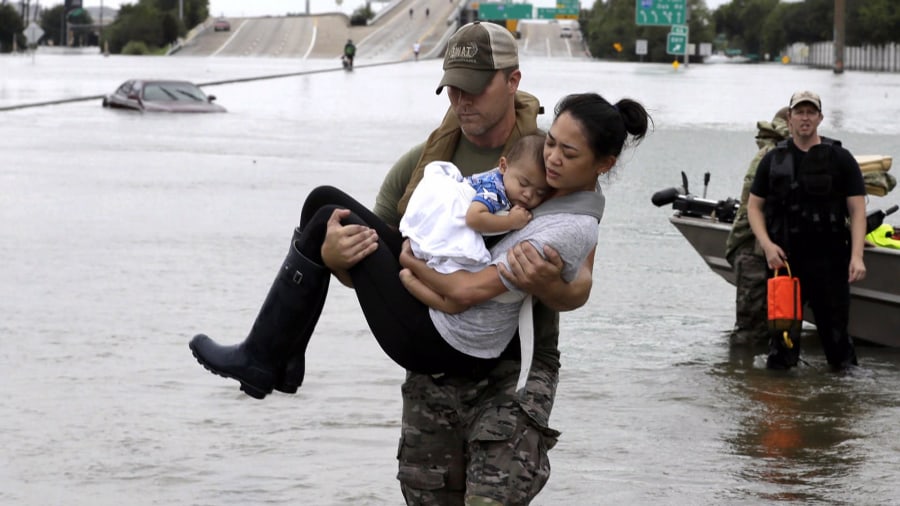Category Archives: Propaganda
Paper and Postcards – Telling a More Complete Military Story

USS Quincy (CA-39) photographed from a Japanese cruiser during the Battle of Savo Island, off Guadalcanal, 9 August 1942. Quincy, seen here burning and illuminated by Japanese searchlights, was sunk in this action. To the left of the image, USS Vincennes (CA-44) can be seen burning in the distance (image source: Naval History and Heritage Command | NH 50346).
Although I am not much of a ephemera collector or fancy myself a philatelist, there are certain aspects of these areas of collecting that interest me. More specifically, if there are ephemera or postal items that connect with or align to my focus areas, I try to grab them in an effort to augment my collection.
People might see the term ephemera and wonder what it means. What sort of item can be characterized or classified as such? In order to answer that question, at least for myself, I proceeded to search the internet. One of the first items within the search results was the organization that is dedicated to these collectors, the Ephemera Society of America, who characterizes it this way:
“Ephemera includes a broad range of minor (and sometimes major) everyday documents intended for one-time or short-term use. The 402-page Encyclopedia of Ephemera lists more than 500 categories from bookmarks to fruit wrappers to posters to theater tickets.”
For this article, the specific categories (presented among the group’s list of 26) that I am touching on are photographs, postcards, and brochures. In some cases, a few of my items (such as real photo postcards) span multiple categories.
In 2009, I published my first book (and hopefully, many more to come though much time has passed since then without a subsequent offering) about the naval warships that bore the name USS Vincennes. In the process of assembling my collection of artifacts that would be used to provide the readers with some visual references, I realized that I had amassed a significant group of items relating to the CG-49. I also realized that though I had a smattering of items, I was really lacking in anything associated with, at the very least, the two WWII cruisers. This realization catapulted me into active militaria collecting that was very focused.
Since I started writing about militaria, I have authored articles (see below) that include a smattering of some of the items from my own USS Vincennes collection.
- Subtle History – Finding a Unique Naval Militaria Piece
- Collecting U.S. Navy Uniform Ship Identifiers
- Remember Me When You Sleep… Sweetheart Pillow Covers
- Spark Your Collection: Military-Themed Zippos
- A Mere Symbolic Plank: A Navy Ship Plankowner’s Perception
The items documented in these posts represent a growing and well-rounded and ever-increasing group of Vincennes-related militaria and would make for a nice arrangement or display. With my ephemera and philatelic additions, this collection (and any subsequent displays I might set up) takes on a more vibrant and colorful appearance.
The philatelic pieces (covers) from the CA-44 cruiser all date from the late 1930s and provide a documented timeline of the ship’s early years of service. The cover from the CL-64 documents the launching of the second Vincennes cruiser in 1943. Combining the ephemera (photographs) and philatelic pieces, my collection has depth and dimension.

The Japanese produced postcards depiction of the Savo Island battle is not too far from the reality (see the Japanese photo of the Quincy burning and foundering – above) of what took place overnight, August 8-9, 1942.
One of the more interesting artifacts in my collection is a postcard that published during the war. When I saw the postcard listed for sale, I noted that it was being sold by someone located in Japan and the text of the listing was lacking details but the title and the artwork were enough to motivate me to submit a bid. The postcard’s face featured an artistic depiction of three American cruisers, wrecked and burning among shell-geysers (as the Japanese ships pressed their attack upon the wounded American cruisers) that, while meant to serve as propaganda, was actually close to what truly happened. I asked a friend translate the Japanese text which revealed the title of the image as, “Night (Attack) Warfare at Tulagi.” The caption states that the painting was displayed at the second Great East Asia War Art Exhibition, which was held in 1943.

The reverse of the Savo Island battle postcard. I have been meaning to re-send a higher resolution scan my friend so that it too, can be translated.
The ships that are depicted in the image are (unknown to the Imperial Japanese Navy officials at the time) the USS Quincy, USS Astoria (CA-34) and the USS Vincennes. All were left disabled and burning after a night engagement by Admiral Gunichi Mikawa’s task force at Savo Island. This painting was a propaganda piece that was more fact than inflated story-telling as the attack was the largest surface defeat suffered by the U.S. Navy during WWII.
I was quite surprised to find such a piece existed and was elated to obtain it for my collection.
Drawing in Recruits: Posters and Broadsides
Tonight, as I was finishing up some research for one of my genealogy projects, I found myself clicking through a series of online auction listings of militaria that would look absolutely fantastic hanging on the walls of my “war room.” My mind began to wander with each page view, imagining the various patriotic renderings, designed to inspire the 1940s youth to rush to their local recruiter to almost single-handedly take on the powers of the Axis nations.

Originally created for Ladies Weekly in 1916, the iconic image of Uncle Sam was incorporated into what is probably the single, most popular recruiting poster that began its run during WWI (source: Library of Congress).

Rather than focusing on the raging war in Europe, this Charles Ruttan-designed poster demonstrates the career and travel opportunities.
Recruiting posters are some of the most collected items of militaria as their imagery conjures incredible emotional responses, such as intense national sentiment, inflamed hatred of the new-found enemy or a sense of call of duty. The colorful imagery of these posters inspires considerable interest from a wide range of collectors, in some cases driving prices well into four-digit realms.
Most Americans are familiar with the iconic imagery of Uncle Sam’s “I Want YOU for the U.S. Army” that was created and used in the poster by James Montgomery Flagg, making its first appearance in 1916, prior to the United States’ entry into World War I. While this poster is arguably the most recognizable recruiting poster, it was clearly not the first. Determining the first American use of recruiting posters, one need not look any further than the Revolutionary war with the use of broadsides, one of the most common media formats of the time.
The use of broadsides, some with a smattering of artwork, continued to be utilized well into (and beyond) the Civil War with both the Army and Navy seeking volunteers to fill their ranks. With the advancement of printing technology and the ability to incorporate full color, the artwork began to improve, adding a new twist to the posters, providing considerable visual appeal. By the turn of the twentieth century, well-known artists were commissioned to provide designs that would evoke the response to the geopolitical and military needs of the day.
- Known as a broadside, this poster mentioned that able-bodied men that were not headed for Army ranks would be enlisted into Naval service.
- This is a beautiful example of a Revolutionary War broadside is recruiting soldiers for service in General Washington’s Army for Liberties and Service in the United States (source: ConnecticutHistory.org).
Adding to the appeal for many non-militaria collectors is artist cache associated with many of the recruiting poster source illustrations. The military brought in the “big guns” of the advertising industry’s graphic design, tapping into the reservoir of well-known artists; if their names weren’t known, their stylings had permeated into pop culture by way of ephemera and other print media advertising. In addition to James Flagg, some of the most significant (i.e. most sought-after and most valuable) Navy recruiting posters were designed by notable artists such as:
- Howard Chandler Christy’s famous “Christy Girl” poster from World War I.
- This sailor extends his hand to would-be recruits encouraging them to climb aboard and join the fight. McClelland Barclay incorporated his advertising industry experience in graphic-design and style into these recruiting posters.
- The Naval Construction Battalion (CB or “Sea Bees”) was proposed in 1941 and established immediately following the Pearl Harbor attack. This poster (illustrated by John Falter) was used to attract journeymen construction tradesmen who would build all of the bases and airfields used to push the Japanese back to their homeland, one island at a time.
- Another McClelland Barclay poster showing a naval aviator climbing into his open-cockpit aircraft with a battleship mast and superstructure showing in the background.
- These sailors rapidly load the naval gun as they are actively engaged in combat. This imagery (by McClelland Barclay) was designed to fan the flames of nationalism and nudge those seeking to avenge the Japanese attack on Pearl Harbor.
Sadly, with my limited budget and my unwillingness to horse-trade any of my collection, these posters are somewhat out of my reach. It goes without saying that condition and age along with desirability have direct impact on value and selling prices. Some of the most desirable posters of World War II can sell for as much as $1,500-$2,000. For the collector with deeper pockets, Civil War broadsides can be had for $4,500-$6,000 when they become available. I have yet to locate any of the recruiting ephemera from the Revolutionary War, so I wouldn’t begin to speculate the price ranges should a piece come to market.

The citizens of a small Indiana town (Vincennes) raised enough money through a successful bond drive to meet the Secretary of the Navy’s financial requirement which resulted in the already under construction light cruiser (CL-64) to be named Vincennes.
Discouraged as I may be in my quest to secure one of these treasured prints, I may be better off seeking quality reproductions to adorn the vertical white-space of my war room. However, a few years ago I received a reproduced war-bond drive poster – the original was created to encourage Hoosiers to buy bonds to name a new cruiser to honor the (then) recently sunk USS Vincennes.
Note: All images not sourced are provided courtesy of the Naval History and Heritage Command











